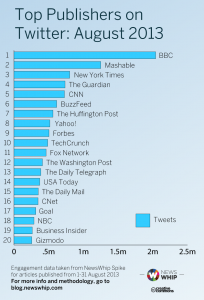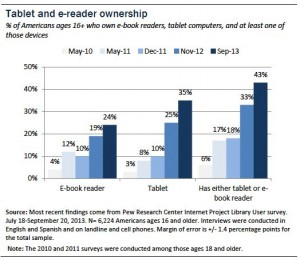We know that many of you are hungry for data to help you keep up with current media industry trends and prepare for changes that are just around the corner. To help you do just that, we’ve started compiling excerpts from some of the key stories covering those issues each month.
This month’s selections cover a range of topics, including what’s happening with publishers on social media, the future of news, tablet sales, print’s prospects, and more.
Top Social Publishers August 2013: Sharing Way Up for All Publishers, and BuzzFeed on Top (NewsWhip)
- In September 2012, NewsWhip measured 44.28 million total Facebook interactions (likes, shares and comments) for the top 50 online publishers. In August 2013, NewsWhip measured almost 117.5 million interactions for the same cohort—an increase of 165% in under 12 months.
- Of August’s top five most social outlets on Facebook, three are online-only publishers—BuzzFeed, The Huffington Post, and Upworthy.
- The BBC performed well, hanging onto the fourth spot and doubling total Facebook interactions, while CNN managed a healthy improvement, going from number seven in September 2013 to number three in August 2013.
- Outside the top five, traditional news outlets, including The New York Times, Fox Network, The Daily Mail, NBC Network, and the Guardian, dominate.
Pew Surveys of Audience Habits Suggest Perilous Future for News (Poynter)
- Pew Research longitudinal surveys find that Gen Xers (33-47 years old) and Millennials (18-31 years old), who spent less time than older people following the news at the outset of their adulthood, have so far shown little indication that they will become heavier news consumers as they age.
- The Pew Research Center’s latest surveys find 58% of Silents (67-84 years old) and Boomers (48-66 years old) reporting they enjoy following the news a lot, compared to 45% of Gen Xers and just 29% of Millennials.
- Readership of newspapers on digital devices such as iPhones, iPads and Kindles is only 8% and 6%, respectively, among Millennials and Gen Xers.
- Among Xers, the Internet news audience jumped from 29% to 49% between 2004 and 2012.
Digital Growth Continues at the Expense of Print (Min)
- A recent forecast from ZenithOptimedia for worldwide ad spending predicts that the gap between digital’s growth and print’s decline will continue to widen, with Internet ad market share increasing from 18.3% in 2012 to 24.5% in 2015, as newspapers and magazines “continue to shrink at an average of 3% a year.”
- In 2012, magazines had an 8.5% share of global ad spending, while newspapers had an 18.7% share. They project that the sums will decline to 7% and 14.9%, respectively, by 2015.
- ZenithOptimedia forecasts that the overall ad-spending market is in for modest growth of 3.5% this year.
Magazine Ad Pages Down Again in Q3, but Decline Is Slowing (Adweek)
- Print ad pages declined 1.8% in the third quarter of 2013 versus the year-ago period, following declines of 4.5% and 4.8% in the second and first quarters, respectively. Year to date, ad pages declined 3.8% to 104,332.
- Advertising in digital editions continues to be a bright spot; tablet ad units grew 17.5% in Q3 and 22% year to date to 21,693. Tablet ads still make up a small slice of the overall ad pie, of course—those ad figures only represent 58 of the 204 magazines titles measured by PIB.
- Health and fitness magazines performed especially well in the quarter—nearly all those titles saw a double-digit ad page increase—as did food magazines and fashion books. Celebrity weeklies also had a strong third quarter, with titles like InTouch, Life & Style, OK! Weekly and Star increasing ad pages by upwards of 40%.
- The weaker magazine categories during the quarter included women’s service titles (Good Housekeeping, Ladies’ Home Journal, Woman’s Day, Better Homes and Gardens, Family Circle, and Redbook all had paging declines) and automotive magazines.
Magazine Launches and Closures Slow in 2013 (Folio)
- Magazine publishers have launched more titles than they shuttered in the first nine months of 2013, debuting 138 titles and closing only 45, according to MediaFinder.com, an online database that tracks U.S. and Canadian periodicals.
- In comparison, 181 launched in 2012, and there were 61 closures.
- In the B-to-B magazine sector, 17 titles debuted and 11 shuttered in 2013, compared with 25 launches and 12 closures over the same period a year ago.
Newspaper Sales Dive Enters 8th Straight Year (Newsosaur)
- As digital advertising sales soared 18% to a record high in the first six months of this year, the revenues of the publicly traded newspaper companies slipped an average of 5.5% to enter an eighth year of decline.
- Paced by a 145% increase in mobile ad sales, digital volume hit a half-year high of $20.1 billion, according to the Interactive Advertising Bureau.
- Assuming digital and newspaper sales pursue the same trajectory for the balance of the year, then digital revenues for the full 12 months will be more than twice the revenues produced by newspapers, whose aggregate sales hit a record $49.4 billion as recently as 2005.
Flipboard Hits 90 Million Users, Nearly Doubles Since April (AdAge)
- Flipboard now claims 90 million users, a jump from the 85 million Flipboard CEO Mike McCue confirmed in early September, and a leap from the 53 million the company announced in April.
- Flipboard said its users now flip a total of 7 billion pages per month, a 1 billion pageview-per-month increase from just six months ago.
57% of Americans Go Online With Cell Phone (MediaPost)
- According to a new survey by the Pew Research Center’s Internet & American Life Project, 63% of cell owners use the Internet and/or email on their cell phone.
- Since 91% of Americans are cell phone owners, this means that 57% of all Americans now go online using a mobile phone.
- Over half of all adults (56%) now own a smartphone, and 93% of these smartphone owners use their phone to go online.
Piper: More Than Half of Teens Own an iPhone; iPad Immensely Popular (Apple Insider)
- Piper Jaffray analyst Gene Munster found that the iPhone represents nearly 55% of all phones used by teens in the United States. That figure is up seven percentage points from the last Piper study, conducted in April of this year.
- Sixty-five percent of teens said they planned for their next phone to be an iPhone, up from 62% in April.
- Sixty-eight percent of tablet-holding teens reported that they own an iPad.
- Those teens saying that they plan to buy a tablet in the next six months are overwhelmingly future Apple buyers, with the iPad holding a 64% share.
Tablet Sales Are on a Tear, While Desktop Swoon Continues (GigaOM)
- The latest numbers from Gartner show tablet sales skyrocketing an estimated 53.4% this year to 184 million units, from 120 million units in 2012. And the woebegone desktop category continues to struggle—exhibiting an 8.4% decline year over year to 303 million units shipped from 341 million for last year.
- As for phones, by far the biggest category in terms of units, growth is expected to be 3.7% for the year with volume of 1.8 billion units shipped, up from 1.74 billion last year.
- The market across all devices is driven by a shift to lower-cost devices, according to Gartner.
- As far as device operating systems go, Android still leads by a wide margin over Windows, which saw a decline of about 4.3%, and Apple’s iOS is in third place.
One in Three Americans Owns a Tablet, but Demand Is Slowing for E-readers (TabTimes)
- Surveying 6,224 Americans aged 16 or older from July 18 to Sept. 20 as part of its Internet Project, Pew found that the number of people owning tablets had grown from 25% in November 2012 to 35% just 10 months later.
- Tablet ownership was skewed heavily toward younger people, high earners, college graduates and—perhaps more surprisingly—English-speaking Asian Americans.
- Pew said that e-reader ownership jumped from 10% in December 2011 to 25% in September 2013, during which time tablet ownership shot up by 25%.
- 43% profess to have both, which is 10% more than the year before.
A Third Read Tablet Magazines ‘Cover to Cover’ (Digital Publishing)
- Almost one-third of consumers read tablet editions of magazines “cover to cover,” according to research Hearst Magazines UK released to Media Week.
- Of the people questioned, 31.4% said they read a digital issue “cover to cover” in a linear manner. In contrast, only 7.3% said they scrolled through small thumbnails of the pages to navigate the app, while 6.4% use navigation features on the front cover or contents section to jump to certain articles.
- On average, readers claimed to pick up a digital copy and read it four times per issue and read an average of 67.8% of their copy.
- Consumers claimed to spend 103 minutes reading the digital edition, nearly double the amount of time readers claimed to spend on a print issue in separate Professional Publishers’ Association research 13 years ago.
Study: Pinterest Tops Twitter in Driving Traffic to Publishers (WAN-IFRA)
- For the second year in a row, publishers are getting more traffic from Pinterest than they are from Twitter, according to a new study by Shareaholic, which tracked how eight of the most popular social networks are helping deliver traffic to publishers.
- The survey, which looked at some 200,000 publishers that together reach more than 250 million unique visitors, found that Facebook holds a firm lead, with more than 10% of traffic coming from it alone, but Pinterest is a solid second, firmly ahead of Twitter.
- Together, Facebook, Pinterest, and Twitter accounted for slightly more than 15% of traffic in September.
News Site Study: 33% of Twitter Referrals Return Within a Week (Journalism.co.uk)
- According to a study by real-time analytics platform Chartbeat, around 80% of those who come to a site directly will come back within one week, compared to a return rate of about 30% overall.
- People accessing a news site via “dark social,” where links are shared in private networks such as via emails or instant messenger, are the second-most-likely category to return, with almost 50% visiting a second time in the same week.
Media Metrics is a new monthly feature from Technology for Publishing, aimed at keeping you armed with the latest industry data. If you’d like to share something you’ve read, drop us a note. And keep up with the latest industry news coverage by signing up for our This Week in Publishing emails or our monthly Publishing Trends newsletter.
Posted by: Margot Knorr Mancini


